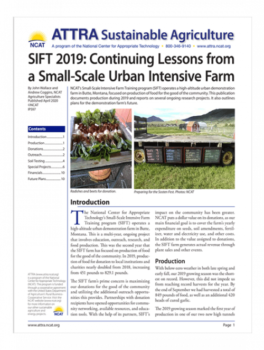SIFT 2019: Continuing Lessons from a Small-Scale Urban Intensive Farm
By John Wallace and Andrew Coggins, NCAT Agriculture Specialists
Abstract
NCAT’s Small-Scale Intensive Farm Training program (SIFT) operates a high-altitude urban demonstration farm in Butte, Montana, focused on production of food for the good of the community. This publication documents production during 2019 and reports on several ongoing research projects. It also outlines plans for the demonstration farm’s future.

Radishes and beets for donation. Photo: NCAT
Contents
Introduction
Production
Donations
Outreach
Soil Testing
Special Projects
Financials
Future Plans
Introduction
The National Center for Appropriate Technology’s Small-Scale Intensive Farm Training program (SIFT) operates a high-altitude urban demonstration farm in Butte, Montana. This is a multi-year, ongoing project that involves education, outreach, research, and food production. This was the second year that the SIFT farm has focused on production of food for the good of the community. In 2019, production of food for donation to local institutions and charities nearly doubled from 2018, increasing from 451 pounds to 829.1 pounds.
The SIFT farm’s prime concern is maximizing our donations for the good of the community and utilizing the additional outreach opportunities this provides. Partnerships with donation recipients have opened opportunities for community networking, available resources, and education tools. With the help of its partners, SIFT’s impact on the community has been greater. NCAT puts a dollar value on its donations, as our main financial goal is to cover the farm’s yearly expenditure on seeds, soil amendments, fertilizer, water and electricity use, and other costs. In addition to the value assigned to donations, the SIFT farm generates actual revenue through plant sales and other events.
Production
With below-zero weather in both late spring and early fall, our 2019 growing season was the shortest on record. However, this did not impede us from reaching record harvests for the year. By the end of September we had harvested a total of 849 pounds of food, as well as an additional 420 heads of cured garlic.
The 2019 growing season marked the first year of production in one of our two new high tunnels purchased through the EQIP program. This, along with a portion of our cover crop test plot that was put into production, helped to expand our production area.
All estimated values of donations and harvest yields were set using direct market sales data compiled since 2015. These prices have been adjusted over the years using comparable farmers market prices and consideration of local grocers’ prices. Our crops are not marketed as organic, as we are not certified organic. We advertise our produce as fresh, local, and naturally grown. Our prices are typically set lower than the comparable organic product but higher than conventional.
Donations
The Butte Emergency Food Bank is a priority donation point for SIFT produce. This is where most of our bulk harvest is delivered, due to the food bank’s capability to distribute food widely and quickly. Of the 829.1 pounds of food donated by SIFT this year, more than half went to the food bank. In return, the food bank has begun supplying the SIFT farm with compostable food waste, which we turn into organic soil amendments.
On another front, collaboration with MSU Extension Butte-Silver Bow County has provided an opportunity to utilize SIFT produce in a series of community nutrition classes for low-income adults and SNAP recipients. By using fresh produce and made-from-scratch recipes, this program teaches participants how to make food dollars go further. The SNAP-Ed program accepted 250 pounds of donations and was often willing to adapt its curriculum to include whatever was seasonally available.
The Belmont Senior Center offers discounted lunches for senior citizens. When SIFT farm yields are excessive for any single donation point, excess produce has been given out to the senior center visitors. This venue has become a great place to talk about growing food with the senior citizens, who have been very appreciative of the fresh vegetables that they can take home.
To end the growing season, SIFT partnered with the Butte Food Co-op Seed Fund and the Dish-ability food truck for a benefit using all-local food. The food donated was cooked by the SIFT Farm Manager and clients of Dish-ability. This was an opportunity to teach food preparation and work skills to those with disabilities, while generating funds to begin a local, cooperatively owned grocery.
Outreach
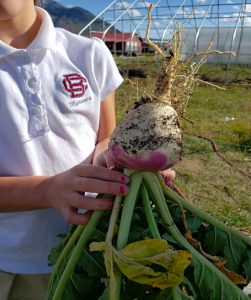
YMCA summer program – farmers in the making. Photo: NCAT
YMCA – School Gardens
The local YMCA has partnered with NCAT since 2017 to provide gardening and farming exposure and education for young kids at the SIFT demonstration farm. Starting in the last week of April 2019, the YMCA after-school program began preparing for the spring and summer season. Preparation started indoors at NCAT, where Courtney Nucito (Food Corps) and Victorian Tilley (Energy Corps) led groups of Kindergarten through 5th-grade kids in planting seeds, discussing soil, and creating vermicomposting systems.
When the snow finally melted away and the weather got a bit warmer, “Miss Courtney” and “Farmer Vic” conducted educational activities outdoors in the kids’ allocated plot on the SIFT farm. By then, plans to build raised beds and generally make the area more organized had been executed. Courtney secured a large amount of good soil to be added to the plot and Victorian, with the help of other farm staff, had taken scrap materials from older hoop houses that had been disassembled and created six raised beds measuring eight feet by four feet each. These beds were filled with soil from the disassembled hoop house areas and mixed with new soil Courtney acquired. New soil was also added to the north side of the plot, which is just an open area with slightly raised beds. Ace Hardware donated equipment, including new shovels, rakes, trowels, and gloves. The new layout and the donations benefited the kids by creating nice-looking and well-defined growing areas using recycled materials, so they know where to step. They also had new tools to use and good soil. Another interesting garden tool that was added to the kids’ area was a Grow Tower, a vertical growing system about four feet tall with 50 slots for plants to grow in and through. It was filled with soil, and young plants were transplanted into each slot. A vermicomposting system is built into the center, with drainage holes on the sides and a tray at the bottom to catch the “worm tea.” This system is a great tool for learning about growing food in smaller spaces and for increasing knowledge about growing techniques in general.

YMCA summer program – farmers in the making. Photo: NCAT
When the season was in full swing and the kids were out for summer break, the YMCA Summer Program kids visited their plot early in the day, once a week. They transplanted flowers, seeded loads of radish, turnip, and greens, as well as some potatoes, which they thoroughly enjoyed. The radishes, turnips, dark leafy greens, and one giant sunflower did particularly well, and the kids were eventually able to haul a bountiful harvest back to the YMCA, where they used the food for snacks and meals. On one harvest day, we brought some hummus for all of us to dip our fresh radishes into. Other gardening and craft activities also took place in the plot, like releasing lady bugs, building a worm composting system, decorating the raised beds with handprints, and sometimes going over to say hello to the chickens. The kids were aware of the composting bays and would put garden scraps in the bays. The goal for next year is to put more focus and maintenance on that system.
The growing season wrapped up in the middle of September 2019. The plot was cleaned up, the Grow Tower emptied, and supplies put away. In preparation for the next season, Victorian laid mulch down throughout the plot, mainly in the walkways, to minimize grass and weed growth for next year and continue to improve the soil in that area. Victorian will continue coordination between NCAT and the YMCA’s kids plot in 2020, with goals to increase and record production, increase compost maintenance with hopes of creating a finished soil amendment, and continue to improve the aesthetic and kid-friendly appeal, as well as the functionality, of the area.
Additional Outreach
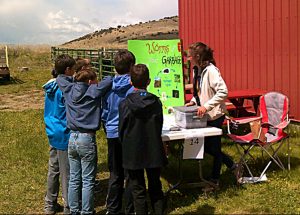
Victorian at the Mile High 6th Grade Day in Cardwell, MT. Photo: NCAT
In addition to this year’s YMCA activities, the SIFT farm hosted five workshops between July and September: Fruit for Butte, Extend Your Growing Season with High Tunnel Construction, Creating Healthy Soil, Selecting Vegetable Varieties for Butte, and Seed Saving: Understanding Its Importance to Biodiversity. Based on post-workshop surveys, the attendance of these workshops was heavily dependent on advertisements in the newspaper. Those who attended were mostly satisfied with the content of the workshops and found the information useful. We received a few comments that the schedule of the workshops was not conducive for attendance, which should be taken into consideration in scheduling future workshops.
The SIFT farm also played a significant role in the public Sosten Fest held at NCAT on June 8, 2019. Despite inclement weather, we offered self-guided tours and a plant sale, and we engaged with the community during workshop demonstrations. There was a steady flow of visitors around the farm, as well as a successful plant sale. Information stands were built and placed around the farm for visitors to learn about regenerative soil practices, season extension tools, and varieties of crops suitable for Southwest Montana’s climate.
The majority of the SIFT farm outreach in 2019 was conducted by John Wallace and Victorian Tilley. Victorian also conducted outreach work in elementary schools with Courtney Nucito.
SIFT farm manager John Wallace presented two classes at the Butte Silver Bow Public Library in partnership with the Butte Community Garden: Conserving Water with Micro-irrigation and Saving Seeds. SIFT also partnered with the SNAP-Ed program to teach about growing microgreens and their health benefits. This class was held at an affordable housing unit in Butte for those who receive SNAP benefits. The same tutorial was also taught at NCAT’s 2019 Armed to Farm training in Montana.
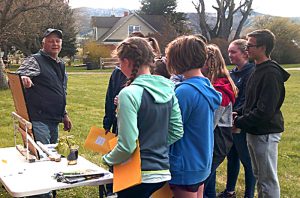
Andrew at the Mile High 6th Grade Day in Cardwell, MT. Photo: NCAT
During 2019, we conducted personal tours and workshops with groups who had high interest in the SIFT demonstration farm:
- UM-Western Environmental Science Class interested in sustainability and regenerative soils
- Local youth interested in building their own community garden
- Upward Bound interested in compost and vermicomposting
- Butte Squad interested in gardening tips
Additionally, SIFT has been involved in extensive one-on-one technical assistance with beginning farmers in neighboring communities over the past year. Notably, two of these operations have just become fully operational.
Students from the neighboring Hillcrest Elementary participated in an indoor class on vermicomposting, followed by an on-farm visit to make their own potting soil and plant their own seeds. Victorian Tilley and NCAT Regional Director Andrew Coggins also visited a Cardwell Outdoor Classroom event to teach about rainfall absorption and groundwater.
Soil Testing
Haney tests for overall soil health were conducted on August 5, 2019, within the same time frame they were taken in 2018. This test reports levels of key soil-health indicators, such as soil organic matter, soil pH, carbon, and nitrogen. One thing to note is that even though the tested plots were watered occasionally, this is effectively a dryland scenario with low precipitation, and therefore we expect organic matter improvements to be small and gradual.
The tests this year showed most indices still declining or inconclusive, illustrating the need for additional visual observations, water infiltration tests, and long-term investment in improving soil health — particularly in non-irrigated, low-precipitation areas. From the table below, the implication is that the cover crops are still taking more nutrients out of the soil than they are adding to it, though we expect to build up both organic matter and nutrients over time — particularly in the north plot, as the center plot starts to suffer from increased compaction and more regular disturbance of the soil microbiology.
We also take Haney tests on a yearly basis in each high tunnel, first as a baseline indicator and yearly thereafter. This yearly testing will continue until 2021. In addition, this year we also took soil tests on two other areas, just as a snapshot in time and partly because these two areas had also been tested for heavy metals in 2018.
Limitations of Soil Testing
Haney tests or other soil tests should not be used as the only indication of soil health. Records and background knowledge can also help with soil-health assessments. For example, up to 2018, the Food Bank/YMCA beds had been underutilized. Also, low organic matter results for the area that had been under asphalt were expected. As another example, the High Tunnel 1 baseline figure was derived from a combination of soil samples from Hoop House 1 and Hoop House 4.
| Key Indicators | |||||
| Year | Soil pH | Soil organic matter | Carbon ppm | Total N ppm | Organic N ppm |
| 2017* | 6.8 | 3.6 | 229 | 27.8 | 16.5 |
| 2018 | 6.6 | 2.3 | 119 | 15.1 | 11.8 |
| 2019 | 7.1 | 2.2 | 114 | 11.1 | 9.4 |
| * Baseline figures include the whole area (60 feet x 40 feet), encompassing North, Center, and South plots. | |||||
| Key Indicators | |||||
| Year | Soil pH | Soil organic matter | Carbon ppm | Total N ppm | Organic N ppm |
| 2017* | 6.8 | 3.6 | 229 | 27.8 | 16.5 |
| 2018 | 6.6 | 2.1 | 150 | 14.7 | 12.2 |
| 2019 | 7.1 | 1.8 | 115 | 13.8 | 11.4 |
| * Baseline figures include the whole area (60 feet x 40 feet), encompassing North, Center, and South plots. | |||||
| Year | Soil pH | Soil organic matter | Carbon ppm | Total N ppm | Organic N ppm |
| YMCA area (2019) | 7.4 | 3.4 | 157 | 24.7 | 15.4 |
| Asphalt area – SE corner (2019) | 7.1 | 0.9 | 87 | 8.3 | 6.6 |
| High Tunnel 1 (2018 baseline) | 7.1 | 3.3 | 122 | 14.1 | 11.5 |
| High Tunnel 1 (2019) | 7.1 | 2.9 | 131 | 30.8 | 13.7 |
| High Tunnel 2 (2019 baseline) | 6.9 | 3.7 | 182 | 28.6 | 19.1 |
| * Baseline figures include the whole area (60 feet x 40 feet), encompassing North, Center, and South plots. | |||||
Hoop House 1 had suffered localized flooding from the drip-line system, to the point that some areas were badly compacted with no soil structure and/or anaerobic conditions. Furthermore, both the YMCA area and Hoop House 1 had very slow water infiltration levels, indicating lots of little feet running over the YMCA area and the compaction caused by flooding in Hoop House 1. The Haney test alone would not have indicated the compaction problem with the YMCA area.
Special Projects
Cover Crop Trials
The SIFT farm is now into the third year of its cover-cropping trials and the second year of individual treatments for incorporating residue in the autumn/fall or leaving it on the surface. The eight-species cover crop mix utilized in 2019 remained the same as for 2018: oats, ryegrass, triticale, phacelia, turnips, sweet clover, and hairy vetch broadcast as a mix, and Austrian Winter Peas sown in a grid pattern. The main driver of the cover crop trials is to measure improvement in organic matter, soil pH, and nutrient levels with Haney tests taken at the same time each year, backed up by visual assessments of the crops, the soil profiles, and simple water-infiltration tests.
The cover crop test plots are 20 feet by 40 feet. Each fall, the center plot is mowed and the crop residue incorporated with a tiller, while the north plot is mowed and the high microbial activity left on the surface. In May, both plots were tilled once, ahead of seeding. In the fall of 2019, the process was repeated, with both center and north plots mowed and the center plot tilled again to incorporate the residue. On May 10, both trial areas were broadcast, drilled with peas, rolled, and watered. One unsurprising observation is that the residue does not break down as quickly on the northern plot, where it has been left on the surface over winter (see photo). We hear stories from farmers with high organic matter balancing their rotations based on high-carbon crops, as they cannot keep enough crop residue on the surface, due to high microbial activity. We are not in that position yet.
High residue levels left on the surface over time can be more than just an indicator of lower microbial activity. They can also create practical problems in sowing the next crop through the debris, leaving seed uncovered or sown at incorrect depths.
 |
 |
| The two trial areas were tilled once, as were other areas of the SIFT Farm. Photos: NCAT | |
 |
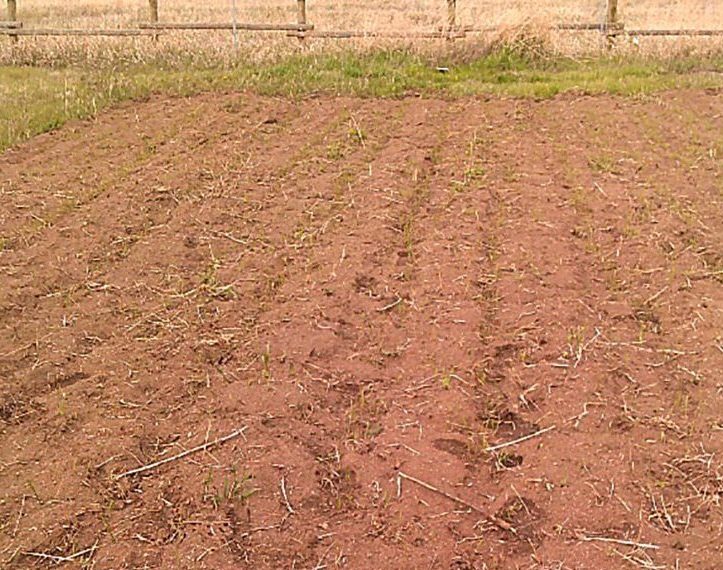 |
| Effectively, the northern bed would have needed tilling twice to produce the same seed bed. Scale that up to mini-till/surface tillage/vertical tillage on a large scale acreage and that would mean double the time and input in the spring, if residue had not been incorporated the previous autumn, unless there was high microbial activity. Photos: NCAT | |
Fruit Trees
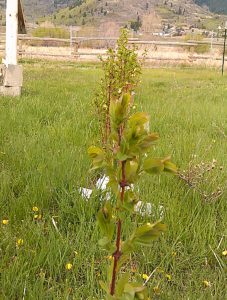
Borealis, which bore some fruit in July.
We decided at the end of 2018 to not expand the fruit tree area in 2019 but to protect what we had and infill the areas where bushes were lost in 2017 and 2018. The four lines of trees running on an east-west axis from north to south are as follows:
- Line 1: 10 Nanking cherries (2017 and 2018). Common across Montana, used as a baseline.
- Line 2: 5 Carmine Jewel cherries (2017) and 5 Juliet cherries (2018)
- Line 3: 5 Borealis honeyberries (2017) and 5 Boreal Blizzard honeyberries (2018)
- Line 4: 5 Svetlana honeyberries (2017) and 5 Boreal Beast honeyberries (2018)
As stated, the main aim for 2019 was to protect what we have, and replace missing plants following some vigorous pruning by vertebrate pests over the 2018-2019 winter. Additional reasons for not expanding at present were that these bushes are currently $25 to $28 each, and we already have three of the newest varieties in the Juliet cherries and Boreal Beast and Boreal Blizzard honeyberries.
This year we were more disciplined and regularly watered the bushes. In addition, a single fence was built around the site in May, the area was mown regularly to keep competitive weeds at bay, and cardboard collars were fitted around the base of the plants, which served a dual purpose of keeping weeds away, as well as keeping the base of the plant cool and retaining water more efficiently. The fence is in the process of being transformed into a simple 3-D fence by adding a second line of barbed wire strung some two feet away from the original. The theory behind this design is that the double strands throw off the perspective of a deer attempting to jump both lines.
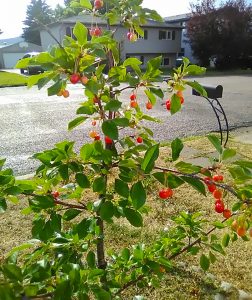
An Evans Bali cherry tree in author Andrew Coggins’ yard in Butte. Photos: NCAT
The most successful cherry bushes to date have been the Juliet variety, and the most successful honeyberries have been the Borealis. The Juliet cherries are one of the newer strains, so this success is perhaps not surprising, but the Borealis is one of the older varieties of honeyberries. It actually bore some fruit last year. Borealis is not popular among large-scale growers, as the plant is bushy and the fruit can be hard to reach – but as we tell visitors to the SIFT farm, Butte’s climate will dictate the optimum varieties for the area!
The Hydroponics System
Our hydroponics system was becoming increasingly complex and problematic, as we attempted to balance out issues around sufficient water flow, organic nutrients separating out, fluctuating pH activity, water temperature spikes, and slimy anaerobic root systems on the plants. These issues were detailed in a blog posted on October 24, 2017. In 2018, due to high tunnel construction, a change to food donation rather than sales, and the expansion of the YMCA garden plots, the hydroponics system was largely dormant. In 2019, we resurrected the system in a much simpler format, influenced by Westley Lund’s experimentation with compost tea in 2017 and a blog on that subject (September 28, 2017). Based on this, Andrew experimented in his office with hydroponic plants grown in a store-bought system, transferring them to a container in the office containing compost tea and using natural daylight and a small pump to aerate it. This process was detailed in a blog posted on July 29, 2019.
Taking this a step further, Andrew then transferred plants from the Miracle-Gro® system directly into one of the lines of the large system in the greenhouse. This line was filled with water and compost tea in a 50:50 mix and aerated by a larger pump initially, but then the smaller pump described in the blog ($9 + $2 air stone). This system was better, with no water pump needed to circulate the water, natural sunlight, heat, and no separation of nutrients, anaerobic roots, or pH problems!
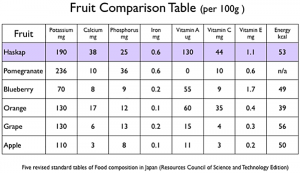
Source: Council of Science and Technology Edition
This trial was conducted on a “see what happens” basis, but the plants kept growing in the system to the point that one basil plant needed trellising at well over three feet tall, having continued to grow in the system all summer, flower, and then set seed. The compost tea was always added in a 50:50 mix with water and the amount of both added was dependent on the temperatures at the time and the size of the plants in the system. A refractometer was used to brix test the sugar content of the tea, but barely registered a result (0.5). The same test was done on basil being grown in the system, but its results weren’t as high as the soil-based basil sample (4-5 versus 6-7). The test was done on September 10, 2019, and, for perspective, cherry tomatoes were measured at the same time, having a reading of 11-12.
With the right tool—such as a bionutrient meter—an important test could be performed to investigate the practical assumption that hydroponically grown plants have a lower nutrient density then their soil-based counterparts. With improved technology, nutrient density of plants could become an increasingly common part of the labelling on fruits and vegetables in the future.
Second High Tunnel
As well as constructing the second high tunnel in 2019, the first high tunnel, constructed in 2018, was fitted with gearboxes and roll-up sides ahead of the 2019 growing season. Installing each side took approximately four hours. Rather like installing the end frames, in this activity you are either left with YouTube videos or your own imagination to complete the construction, as the otherwise excellent instructions are a bit vague here.
 |
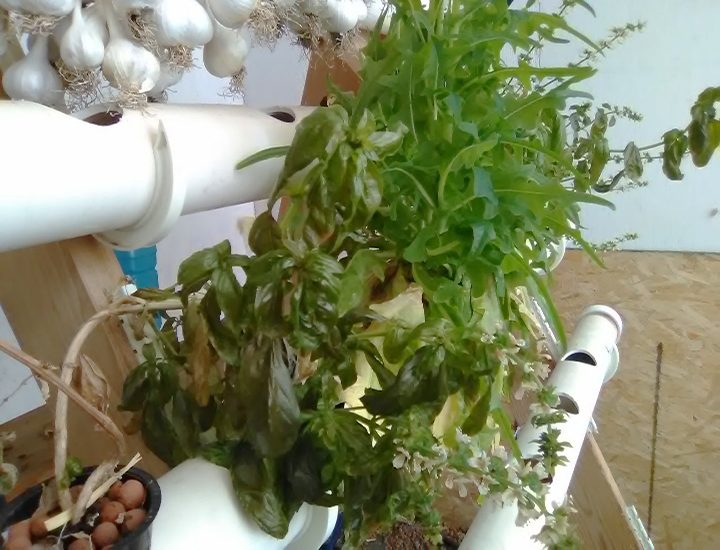 |
| Basil plant that has gone to seed (far right in left-hand photo). The object of the exercise was to see if plants could be sustained on compost tea all summer. Some of these plants survived from April to October (photo on right) when cold temperatures started to take their toll. The remaining plants were removed not long after this photo was taken and, despite frost damage, the roots were still healthy. Photos: NCAT |
|
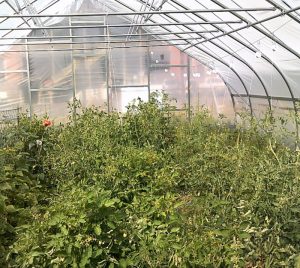 Tomato plants growing in the first new high tunnel before different forms of trellising were fitted. |
 The NRCS approved irrigation system. Photos: NCAT |
The irrigation system was constructed to EQIP program standards and served us well throughout the summer on a single-timed system. Most of the plants in the high tunnel were tomatoes. The irrigation system is designed to prevent a backflow of water through the pipes to the main water supply or, more importantly, to prevent a backflow of fertilizer into the water supply if nutrients are applied through the irrigation system, as is a popular method. The system was inspected and signed off by the NRCS engineer for the area, a different position from the NRCS officer responsible for checking the high tunnel construction. For the irrigation system, water-pressure requirements have to be met, and hose line designed to carry drinking water has to be used. The zone control valve should have a 90psi inlet rating and a 17psi outlet rating, and the pressure vacuum breaker should be 18 inches higher than any sprinkler head or drip line. There are other stipulations, too. Detailed requirements for system design, like the soil testing and nutrient management plans, are contained in the EQIP payment schedule.
Financials
Water usage and costs went up slightly from last year, by 39,313 gallons and $177.87 respectively, but electric use has dropped slightly, by 111kWh and $10.81. The electric fluctuation is not significant and could be weather-related, reflecting the amount of time heat lamps and heat plates were on in the chicken coop. The system also was used to provide power for the high tunnel construction. Increases were not production-related, as the only electrical equipment used in production, the water timers, are battery powered. The water increase is modest, considering the size of the increase in production for donation and produce for the plant sale. Water usage was affected by replacement of old, worn-out drip line and possibly by a simplified water system in the first new high tunnel. The overall take-home from this year’s accounts is that, for the first time, our sales and the value of donated produce exceeded our yearly expenditure and utility bills, which is a milestone. In addition, the number of work hours allocated to the SIFT farm dropped in 2019, so there was a cost reduction in NCAT’s operation of the SIFT farm.
As in 2018, the expenditure on, and income received from, the NRCS high tunnel EQIP program is kept as a separate financial statement.
Income (excluding the NRCS EQIP program):
- $1,237.00 – Plant sale, egg sales, additional sales to staff
- $ 5,021.50 – Food donations (829.1 pounds), plus 420 garlic bulbs
- $ 6,258.50 – Total income
Expenditures (excluding the NRCS EQIP program, Haney tests, and labor/salaries):
- $1,840.69 – Seeds, fertilizers, soil amendments, supplies
- $1,610.11 – Water and electric
- $3,450.80 – Total expenditures
- $2,807.70 – Balance
EQUIP High Tunnel Program cost and grant income over full span of program (2018 – 2019)
Approximate Costs
2 Rimol Nor’Easter 30′ x 36′High tunnels $14, 367 Cedar baseboards $468 Bobcat rental for site preparation $457 Irrigation systems (2) $572 Haney soil test for this project (8) $440 Sundries – Additional hoses, hardware $300 Total costs to date $16,604 Income 2018 – 2021
2 Rimol Nor’Easter 30′ x 36′
High tunnels $8,728 Nutrient management program $2,952 Micro irrigation systems (2) $822 Total income $12,502
Future Plans
At the conclusion of the SIFT demonstration farm’s 2019 project year, we made plans for the future.
- Finish the 3-D fence around the fruit trees.
- Refurbish the east side of the greenhouse to accommodate a donated hydroponics microgreens production system, a scaled-down
version of the home-built hydroponics system running on compost tea, and other small examples of different hydroponics systems. - Remove the rotting timber and beds from the attached greenhouse, and replace them with smaller beds that can be covered and also be used as a platform for plant starts.
- Explore SIFT-related grant funding options, including NRCS EQIP and CSP program opportunities, as well as an additional hands-on site training facility to support other specialist staff and their local community outreach programs.
- Build initial raised beds on the asphalt area and seek funding support to research potential plant uptake of heavy metals on former industrial sites.
- Increase production as the second high tunnel comes into production, build the second micro-irrigation system, and install the roll-up sides with gearboxes.
SIFT 2019: Continuing Lessons from a Small-Scale Urban Intensive Farm
By John Wallace and Andrew Coggins, NCAT Agriculture Specialists
Published April 2020
© NCAT
IP597
Slot 622
Version 050420
This publication is produced by the National Center for Appropriate Technology through the ATTRA Sustainable Agriculture program, under a cooperative agreement with USDA Rural Development. ATTRA.NCAT.ORG.
Related Resources
Videos:
Publications:

